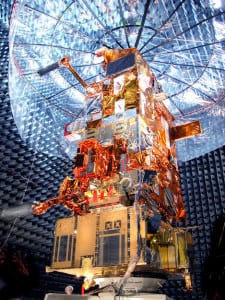Latest News
[Via Satellite 03-28-2014] Airbus Defence and Space has signed a contract with the European Space Agency (ESA) to be the prime contractor for the development and construction of the high-precision Sentinel 5 instrument. The instrument, worth approximately $200 million, will monitor the composition of the Earth’s atmosphere on a daily basis by measuring trace gases and aerosols that have an impact on the climate and air quality.
Sentinel 5 will be installed on a MetOP Second Generation (MetOP SG) satellite, expected to be delivered in 2019 with a launch scheduled for 2021. The spectrometer will provide coverage with a spatial resolution of 7 by 7 square kilometers (2.7 by 2.7 square miles) at nadir, allowing atmospheric and climate scientists to accurately detect and analyze emission sources. This includes determining the concentration of trace gases in the atmosphere such as ozone, nitrogen dioxide, sulfur dioxide, methane, formaldehyde, carbon monoxide and aerosols. The Sentinel 5 contains an ultraviolet, visible, near-infrared and shortwave infrared (UVNS) imaging spectrometer, which is necessary for measuring such molecules. The instrument has a service life of more than seven years and consists of the optical module, including a reflecting telescope, a beam-splitter optical assembly, two ultraviolet/visible (UV-Vis) and one near-infrared (NIR) spectrometer optics, as well as two shortwave infrared (SWIR) systems, a calibration subsystem, and two control electronics assemblies.
“It is only with satellites and their instruments that we can observe the environment globally and continuously. ESA has entrusted us to take the Copernicus program forward by constructing the next key instrument, the high-precision Sentinel 5 spectrometer, at our optical space center in Ottobrunn, near Munich, Germany,” said Michael Menking, head of Earth observation, navigation and science programs at Space Systems. “To date, we are already constructing three Sentinel satellites and various other Sentinel instruments for the Copernicus program that support a modern, efficient infrastructure for Earth observation and geo-information services.”
Get the latest Via Satellite news!
Subscribe Now